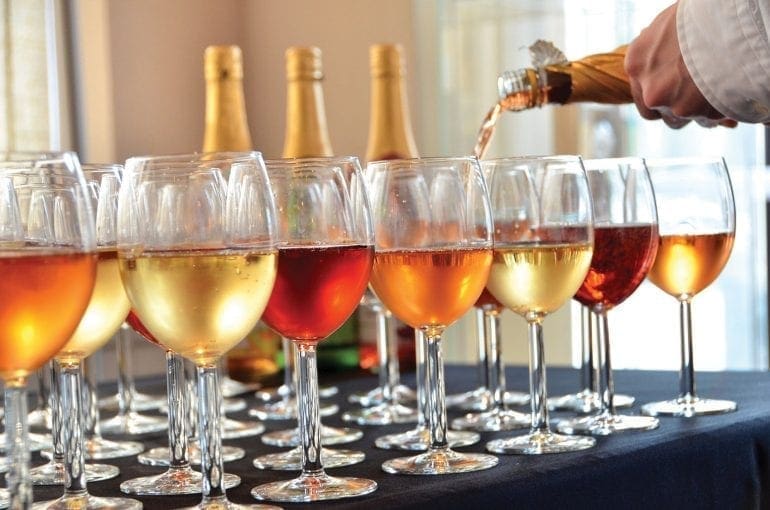By Neil Shrodo | Super Buy-Rite JC
The little black dress has been a constant in the fashion industry since the 1920’s, when Coco Chanel famously published a picture in American Vogue and declared it a “uniform for all women of taste.” Even when it was “out,” like in the conservative ‘50s, it still had its place. Wine, like fashion, follows the seasons—rosés and whites in the spring and summer, reds in the fall and winter. Each year brings something new in wine as well. One year it is oaky chardonnays, then pinot noir, followed by French rosés and sparkling wines.
So what would be the parallel to the LBD? That wine style that always has class, always is in vogue, and is synonymous with celebrations? It always comes back to champagne. It makes every occasion better—the sparkle, the pop of the cork, the fizz in the glass.
Yet, things have changed in champagne. Historically, these wines were made by large companies with famous names such as Moët & Chandon, Veuve Clicquot, and Perrier-Jouët who bought grapes from local vineyards. They made champagne with an eye towards consistency, each with its house style so you always knew what to expect. And thus, its popularity grew.
About 25 years ago, however, as a new generation took over the family vineyards, a group of producers began to hold back some of their harvest each year. These small producers were focused on making distinct champagnes with an emphasis on regional character and high quality. Under the banner of “Small Grower” champagne, they revolutionized the industry by reinventing a classic—wine’s little black dress, for a new generation.
Agrapart & Fils Brut
“7 Crus” NV – $54.99
Superb flavors of white peach, almonds and citrus fruits layer over a surprisingly rich body.
Pierre Gimonnet Brut
“Belles Annees” NV – $39.99
Crisp and minerally yet textured and refined with deep flavors and great intensity.
Marguet RosÉ Extra Brut
“Shaman 15” Grand Cru – $49.99
Aromas of fresh strawberries and ripe cherries. Excellent body, quite zesty mousse and a bright finish.
Wine Trends: Orange Wines
Orange wines are a new, hot trend in organic winemaking—one that uses ancient techniques, some nearly 5,000 years old, from the country of Georgia’s Caucasus Mountains. White grapes were crushed and then fermented with the skins and seeds intact for up to a year resulting in a rich, bold wine that has flavors of jackfruit, hazelnut, juniper, and orange rind. They are intense and unique, most similar to the wines of Jura in France. They have gained popularity in the past few years for another reason though, they use virtually no preservatives because they naturally oxidize as they are made. This makes them the ultimate organic wine, with no preservatives or additives like sulfites.

Due to their intensity, they pair well with cuisines that have a lot of spice and heat, like Ethiopian, Korean, Moroccan, and Japanese. They work with many meats, ranging from beef to fish.
These wines are now made in small numbers in countries like Italy, Georgia, Slovenia, South Africa, Australia, and the United States, some of which are quite rare and expensive. If you want to try a reasonable one, look to Austria, and try Eschenhof Holzer’s “Invaders” Orange ($18.99), a wine made from Muller Thurgau which is dry and full bodied, with flavors of ripe peaches, apples, and a kiss of lemon lime touched with spices.
Great Vintages on the Horizon
Bordeaux: A vintage that is being hailed as one of the greats for this classic French region is one that had a near perfect growing season. The wines are rich and bold, but precise in flavor and style. Try the Château Saint-Emilion de Quintus 2016 ($39.99 on sale) as a wine you could drink or age for over five years.
The Rhone: 2016 was a stunner for both northern and southern rhones, with a long growing season in the north and superb weather in the south. Start grabbing the Chateauneuf du Papes. Look for Beaucastel CdP($89.99) or Crous St Martin CdP ($34.99) and you cannot go wrong.
California: Beginning with Napa, you have three great vintages in a row starting with the 2014’s which are getting better and better in ‘15 and ‘16—a trend mirrored in Sonoma as well. 2016 Chardonnays were great in Napa, Sonoma, Santa Barbara, and just about everywhere.
Italy: You’ve got very good drinking vintages in both the north and south for 2016. Look for Dolcettos and Barberas from the Piedmont, and Chiantis and Tuscan blends from Tuscany. Oddero Barbera 2016 ($18.99) is a good place to start.
All wines mentioned are available at Super Buy Rite JC.
The New Jersey Digest is a new jersey magazine that has chronicled daily life in the Garden State for over 10 years.
- Staffhttps://thedigestonline.com/author/thedigeststaff/
- Staffhttps://thedigestonline.com/author/thedigeststaff/
- Staffhttps://thedigestonline.com/author/thedigeststaff/
- Staffhttps://thedigestonline.com/author/thedigeststaff/


